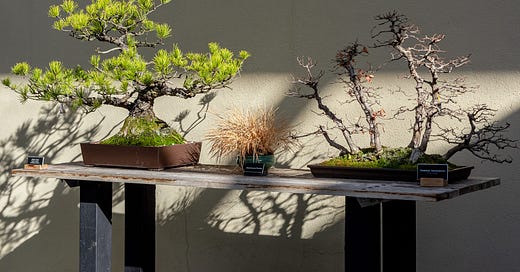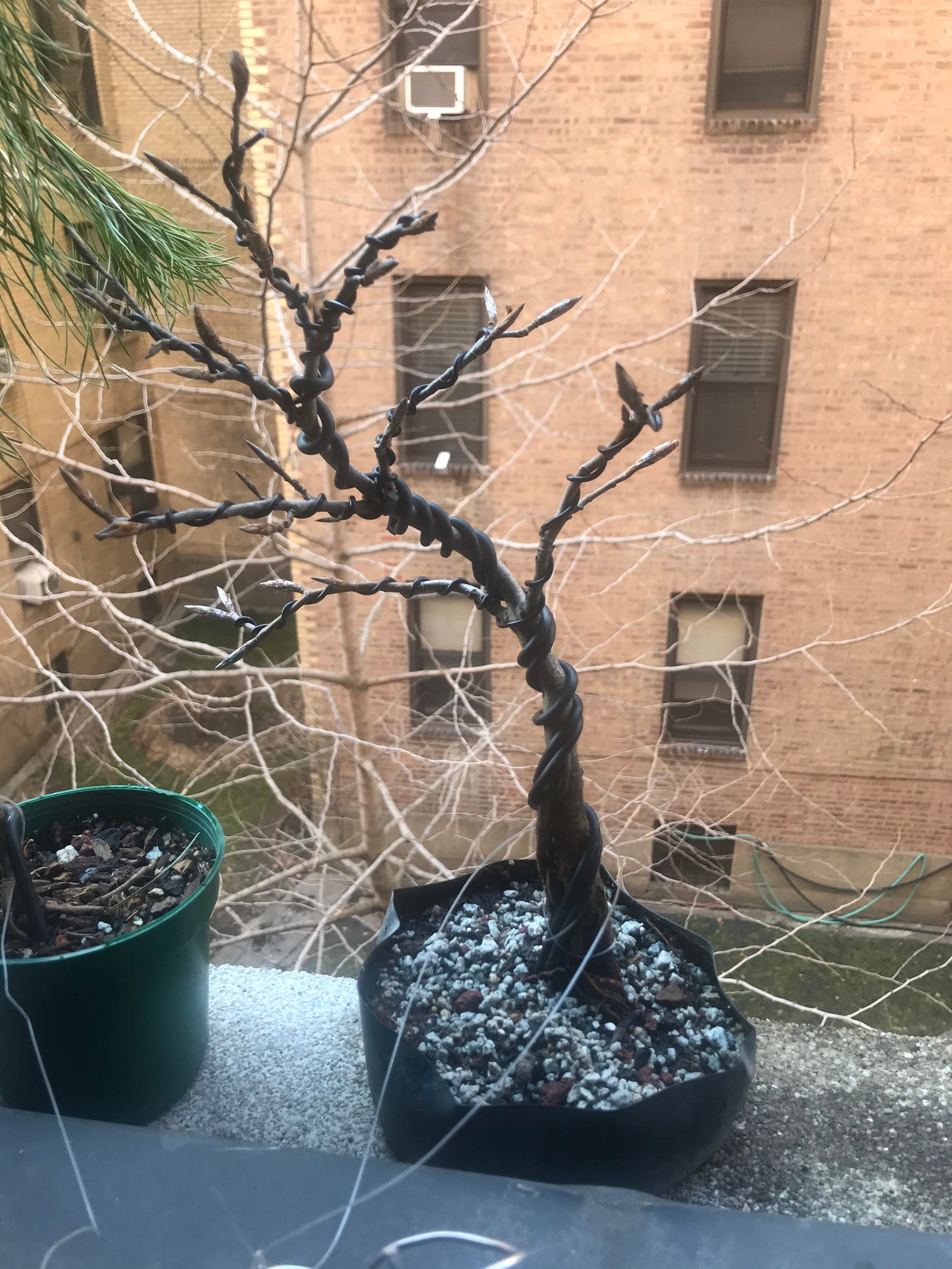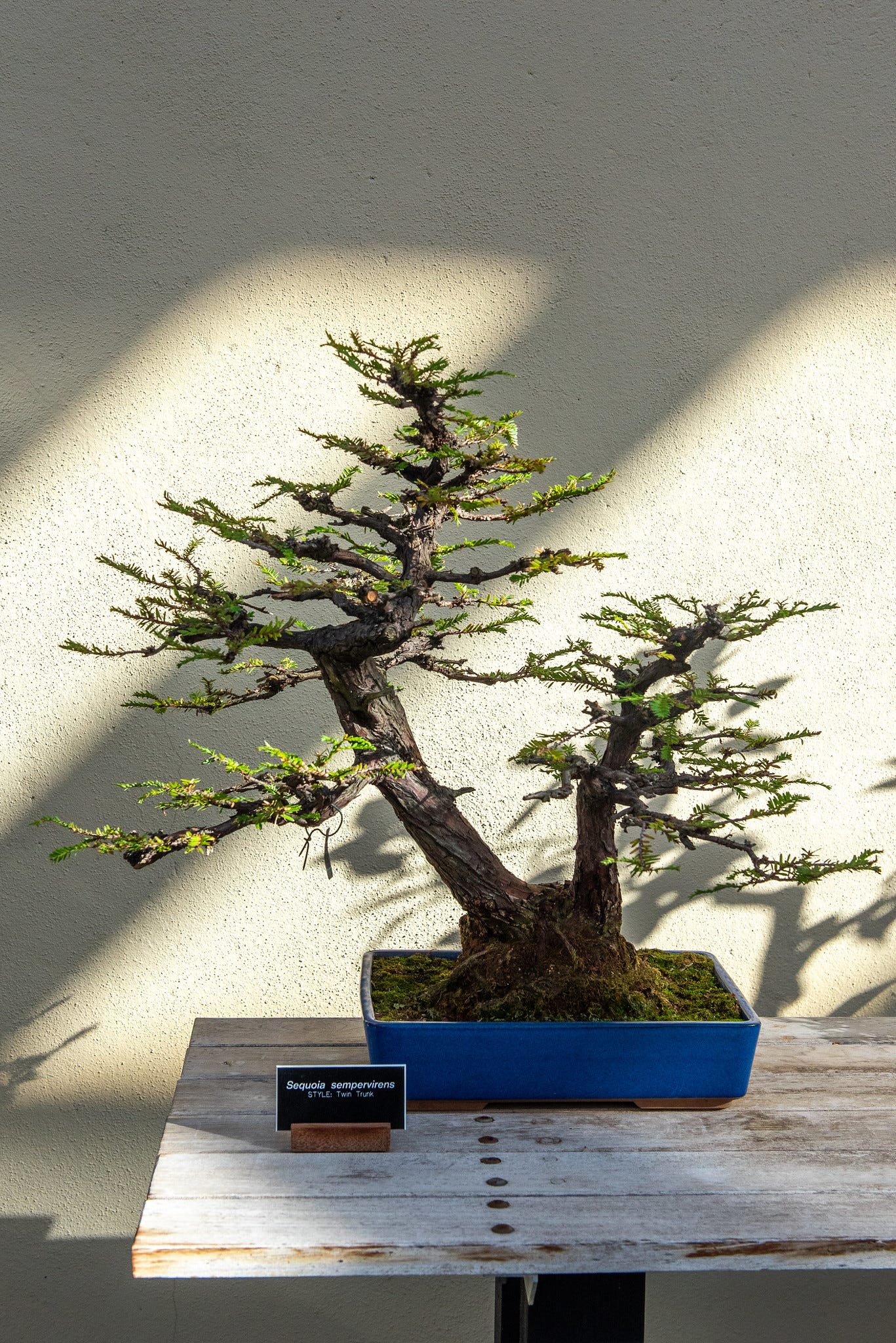In a guide for the educational resource Bonsai Empire, bonsai potter Thor Holvila has this to say about selecting a pot for your tree.
The first thing you must do is to decide if your tree is masculine or feminine. Usually, a tree is a mix of both and question is which sex is the dominant. This is absolutely crucial and perhaps the most important rule in choosing a pot.
You don’t go far in bonsai without encountering gendered principles of aesthetics. A tree is masculine or feminine. This innate character guides the bonsai’s design. Then you select an appropriately masculine or feminine pot to enhance the design. Masculine pots are heavy, angular, and usually devoid of glaze. Feminine pots are full of curves and color.
Holvila provides clues for determining your bonsai’s gender.
Some attributes that can help you along the way is that the curves, grace, smooth bark and sparse branches is considered feminine. The corresponding masculine traits are strength, old bark, deadwood, thick trunk and dense branches.
I find it interesting that in this view, a bonsai may have an essential, inalienable gender, but that in order to bring that aesthetic theory into practice, we also have to acknowledge just how malleable and fluid that gender can be.
Trees are famously weird about sex. Their flowers can contain male and female reproductive parts in the same bloom, in which case they’re called ‘bisexual’ or ‘perfect.’ Flowers and fruit rely on outside parties to spread their pollen and seeds, through intimate acts of invasion and consumption. Then again, trees don’t even need to bother with sexual reproduction to propagate themselves. Many spread asexually by shooting new stems up from their roots.
My limited understanding of the American bonsai world suggests that people are slowly moving away from masculine-feminine bonsai language to be more politically correct, though the idea is persistent. And I think it’s a fine and useful framework for relating to and cultivating the character of your tree. I don’t know if I have any particularly masculine trees, though this sacred fig may turn out that way by the time I’ve developed the trunk into a stout pillar with thick buttress roots.
Meanwhile I’m sure most people would consider this graceful, smooth-barked beech to be characteristically feminine.
Why not rugged trees, sinuous trees, elegant trees? Of course we use all these terms to describe trees too, but I guess they lack the stickiness—the instantaneous recognition—of ideas about maleness and femaleness. Which is also interesting.
The Bonsai Mirai blog describes the idea of masculine vs feminine bonsai like this:
Beyond just describing design, the concepts of masculine and feminine in bonsai can provide frameworks from which to make decisions on how to best maximize the inherent qualities of any tree. These frameworks can guide your thought process in approaching a tree, something to objectively base decisions that supersede your personal design biases. As the idea of what makes good bonsai design can be nebulous, starting with identifying whether the tree is more masculine or feminine can make the overall design process feel less overwhelming.
“Gender as framework” makes sense to me. An aesthetic tool like the rule of thirds that can guide an unsure hand. It’s not the whole deal, but can be a useful starting point. This viewpoint treats gender as a heuristic, which I think is as useful for thinking about people as it is for thinking about bonsai.
I don’t think I ever felt comfortable with my masculinity until I became a practicing bisexual. There’s something about the plurality of ways it’s let me explore how I relate to women, men, and other people—it helps me recognize that maleness isn’t any one thing. Masculinity is pliant and conditional, even customizable. Growing up, I thought it was something to be avoided. Maleness was aggression and competition. Then, remember metrosexuals? In the 00s, they were the future of manhood.
With the benefit of time and more diverse gender experiences, I’ve come to appreciate my own maleness more fully. I love the stupid, rambunctious energy that boys can summon when left to our own devices. Then again, I couldn’t tell you what about that experience is essentially male, other than I’m a man experiencing it.
There’s an idea in philosophy of necessary and sufficient conditions. Necessary conditions are required for something to fit a definition or category, but they might not, on their own or in combination, be sufficient for a thing to really meet that definition. Every bonsai is a tree, but not every tree is a bonsai.
If you study anything in psychology you learn that while necessary and sufficient conditions have an appealing cleanliness to them, that’s not at all how the brain works. How many legs does a chair need for you to recognize it as a chair? Four? Three? What about seats that swing from a ceiling? The beauty of being human is that we’re able to understand the world beyond the rules of formal logic. The new AI language models only know what a chair is because rows of poorly paid human contractors teach them with examples.
What are your necessary and sufficient conditions for masculinity and femininity? Do they apply to bonsai as well as people? Does asking that second question make the first feel more or less silly to answer? You tell me.
Tree reading
A good petition to sign from the organization Climate Forests to the US Forest Service and Bureau of Land Management to specifically protect valuable old growth forests. [Climate Forests]
A brilliant report from Rocky Mountain Bonsai Society member Samantha Holm about the stark gender disparity in bonsai artists and hobbyists. [Rocky Mountain Bonsai Society]







While I tend to regard all my trees as somehow feminine (my bias - it doesn't mean anything to the trees), there are definitely mountain trees and valley trees.
What a great insightful article. I often try to avoid gendered language when describing/analyzing a bonsai but I love the idea of using it as a framework and acknowledging its fluidity and non-binary nature. Some of my favorite trees have masculine and feminine characteristics, just like me. Thanks for your insight.